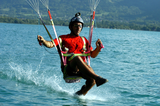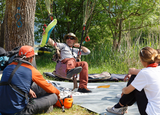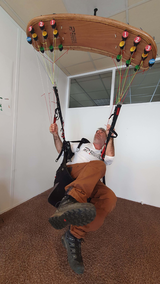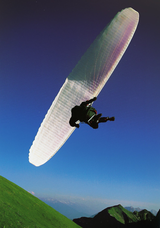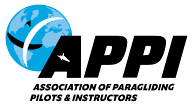
Interview: David Eyraud, the SIV master. Manu Bonte (10914)
29 August 2023INFO | paragliding
Annecy, Europe's SIV Mecca, is where David Eyraud has been training generations of pilots for over 20 years. Interview with THE SIV master.
📣 The 90s, the magic house of Col de Bluffy in Annecy with you, Greg Blondeau and Jérôme Maupoint. All the inhabitants of the nest have gone on to become household names! How did you get into paragliding?
The magic house in Bluffy! Those were good times. I lived and breathed paragliding!
I started paragliding with some friends in 1988. I was 17 and I was immediately interested in the fun side of flying: flying close to the terrain and acro flying.
I flew a lot in the 90s, and until 2000 I spent every winter in South America. The endless summer!
That’s how I met other pilots who shared the same lifestyle. The brothers Raul and Felix Rodriguez, Richard Gallon... and we created the SAT team for Safety Acro Team.
I worked in the paragliding industry as a test pilot for ITV, Edel and then Flying Planet. I also worked as a salesman, for Swing France, but I really don't have the soul of a salesman! On the other hand, I liked to promote the brand with demos and videos. Then I became an instructor in 2000.
📣 You were one of the pioneers of acro. How have you seen this form of practice evolve?
At the beginning, acro was a forbidden and frowned-upon sport. When I did acrobatic evolutions, some people shouted at me "go kill yourself somewhere else!
Between 1996 and 1998, in Switzerland, I took part in the "RedBull Par'Acro", in Villars sur Ollon, whose poster announced "the only acrobatic paragliding competition in the world". A competition on the snow with evolutions marked by judges.
In 1997 and 1998, competitions multiplied: the first RedBull SkyGlide, in Villeneuve on Lake Geneva, but also in Italy, in Malcesine on Lake Garda: the Nafta Watch trophy: acrobatic paragliding and precision landing.
But each event had its own set of rules. The judges were journalists, local pilots, instructors, elected representatives, but by no means specialists. I remember the very first competition in France, at Vars in 1998, above the snow. Stalling was forbidden, but the judges made us do spins!
In the summer of 2000, I had an accident: while testing a student's glider, the lines broke when I was about 20 m from the ground. I fell and injured my back. I've had a bad back ever since! So, for the RedBull Vertigo competition in 2000, I couldn't take part as a pilot. I offered to be a judge. And I realized that this discipline needed to be structured. So I worked on a new set of rules. Then I worked to get these rules recognized by the FAI. I also trained the first aerobatic judges resulting in the first French championships being held in 2003. Then the first world championships in 2006, where I was event director. It’s fair to say that I played my part in making aerobatics an officially recognized discipline in its own right, with competitions, equipment, champions and sponsors.
📣 You are also recognized as the founding father of modern pilot training, SIV and acro coaching. How have these activities evolved?
When I saw the first SIV courses, before the year 2000. I was amazed! The pilots were doing all kinds of collapses, but they weren't being taught how to catch a surge or master the rotation... it was all very folkloric!
I was convinced that the know-how of aerobatic pilots could be of great use to everyone. Not least, for example, in understanding backfly, or pendulum movements.
I had my first students even before I became an instructor, working as a coach. As soon as I became an instructor, teaching piloting became my focus. In fact, at the time, nobody was talking about piloting.
In 2003, I organized a seminar with the FFVL (French Free Flight Federation) and other motivated specialists to develop SIV and piloting courses, as well as the training of SIV instructors.
Since then, I've done almost nothing else! I’ve been supervising around 35 3-day courses a year for over 20 years. That's over 2000 SIV days. In all, I've guided over 40,000 SIV flights at all levels, from near-beginners to recreational, cross-country and acro pilots.
I'm passionate about teaching and I try to improve my tools year after year. My proudest is my website: pilotage-parapente.com launched in 2016. My students used to ask me where they could find explanations on paragliding piloting, and it didn't exist! So I set about creating an e-book that would be as exhaustive as possible, with text, drawings and videos. It took me over 13 years! For the moment, it's only available in French, but that could change. I sometimes run courses in English as well as Spanish. But I never mix 2 languages in the same course. My schedule is full more than 6 months in advance.
📣 What do you think of the APPI system?
I like things to be structured. I'm convinced that teaching techniques need to be harmonized throughout the world. And APPI is the only body to do that!
It's a human-scale structure. Anyone who wants to can get involved and be listened to.
APPI is an agile association that evolves quickly. The Internet platform is highly innovative. Everyone can track their progress, find quality structures and instructors, and find technical explanations. The multilingual aspect is a real plus, giving pilots from all over the world access to clear, structured progress.
📣 What are your plans for the future?
I am convinced that SIV is an important means of improving paraglider pilot safety. And the APPI system has understood this: SIV is at the heart of progression. So we need a lot of competent instructors to run high-quality SIV courses all over the world.
I am going to get more involved with APPI in the training of SIV instructors, passing on my experience as an instructor and instructor trainer. That starts this autumn with a huge project at Oludeniz. It'll be a moment of exchange where we will all make progress!
I'd also like to use the APPI platform to broadcast piloting courses. The aim is to bring to an international audience the work I've been developing for many years in French.
note: see David's e-learning section here
thumbnails


